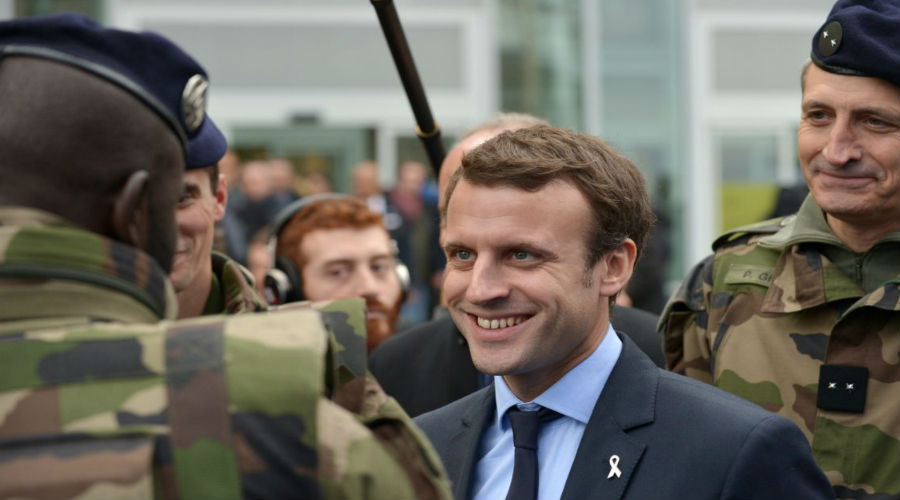France’s military role in Syria is no longer confined to launching strikes against the Syrian regime after it was accused of using chemical weapons in an attack on Douma City, or to cracking down on ISIS elements. That is, Paris started to relatively expand the scope of its military presence, especially in areas where the U.S-backed Syrian Democratic Forces (SDF) are deployed. French forces deployed six artillery batteries in Baghoz, a town in eastern Deir Ezzor, eastern Syria. At the same time, reports emerged of U.S.-French joint forces expanding their presence in al-Hasakah, Raqqa and Ain al-Arab, along lines of contact on the Turkish border and in the heart of the town of Manbij to which Turkey is planning to advance in a second leg of confrontations with the SDF after Afrin. This triggered political skirmishes between Ankara and Paris so severe that Ankara threatened to target the French forces.
Despite increasing talk about France’s growing presence in Syria, its size remains limited with regards to to its reliability on missions. But it can be said that relevant French assessments are not based on quantitative calculations but on other variables related to goals and implications that are inseparable from Paris’ view of the developments in Syria and its impact whether on the balances of power or interests of parties involved in their trajectories.
Multiple Areas
There are assessments that the French special forces contingent operating in Syria is 70-strong, joined later by 30 troops from 1st Marine Infantry Paratrooper Regiment and the 10th Paratrooper Commando Force. Despite indications of deployment of artillery units in Deir Ezzor, the force is likely to have been increased but remains less than 200 French troops, equal to 10 per cent of the U.S. presence in Syria.
These troops deployed are in three areas. The first are SDF-controlled areas, where Paris officially announced that the objectives of their presence there is to prevent any Turkish incursion in Manbij or attacks on SDF. The second are areas where there are French or common French-U.S. interests, including France’s Lafarge cement plant, which French reports showed that its owners had to pay about $50 million to secure it under ISIS’ presence which lasted there for four years, and the al-Omar oilfield, the largest in Syria, around which the new artillery force was deployed. The third are areas close to the Syria-Iraq border through which ISIS elements attempt to infiltrate to both countries.
Different Objectives
Through its military presence in Syria, France seeks to achieve several objectives of which the following stand out:
1- Supporting the sustainability of U.S. presence in Syria. This goal is of special importance for Paris. This was evidenced in statements delivered by French President Emmanuel Macron during his April 24 visit to Washington. Macron said that he convinced U.S. President Donald Trump to stay in Syria because their mission has not been accomplished yet. Although some U.S. officials continue to stress that withdrawal of U.S. troops from Syria is a matter of time, France continues to show an ambition that it wants the United States to maintain military presence in Syria to support European interests and help counter existing challenges, especially those posed by infiltration of ISIS elements into Europe.
2- Stopping expansion of Turkish military operations. The French military presence, along with disagreement with Turkey about its form, reflects a confidence crisis between two member states of NATO. It also shows the depth of the rift in relations between the two states. Remarkably, Turkish media outlets published a detailed map of sites where French troops deploy in Syria. The move was considered by Paris as an attempt to damage its troops because surveillance of the positions puts them in danger.
The depth of the exacerbating crisis between the two sides was clearly reflected by French reports indicating that Turkey is a main gateway through which some ISIS elements sneak into Europe. It is also related to Paris’ dissatisfaction about Ankara’s support of armed groups to target the SDF, as was the case in battles in 2014 in Ain al-Arab or Kobani and other areas, which the SDF liberated from ISIS.
3- Expanding the French role. That is, France’s role would not be confined to diplomatic movements, given that the issue, in France’s view, was previously limited to President Bashar Assad’s staying in power. It appears that it changed its view of the crisis in Syria, due to its fast-paced developments prompting it to consider that the diplomatic mechanism might not be sufficient in this regard. A statement issued by the French president’s office indicated “planned reinforcement”, a term used by French diplomatic circles to describe expansion of military presence in Syria. The statement said stressed that the deployment supports “the stabilization of the security zone in the north-east of Syria, within the framework of an inclusive and balanced governance, to prevent any resurgence of ISIS”, while also supporting the chances of reaching a political solution to the conflict in Syria.
Likely Trajectory
In conclusion, the new French approach indicates a shift in Paris’ view of the developments of the crisis in Syria, in light of recent changes in the balances of power. The talk was first about a limited military presence aimed at filling gaps in intelligence about ISIS’ post-Raqqa movements. But the latest development i.e. deployment of artillery batteries, means that there are military positions or interests that need to be secured by a wider plan. This would mean that Western military presence is likely to be expanded in the coming period in the east of Euphrates and the north of the country. This would have a direct repercussion on relations between Western countries and Turkey, or the position of these countries on minor confrontations that these areas would witness at a later stage, because of the contrasting interests of powers involved in the developments of Syrian crisis.


